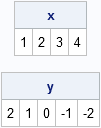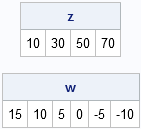It is often useful to create a vector with elements that follow an arithmetic sequence. For example, {1, 2, 3, 4} and {10, 30, 50, 70} are vectors with evenly spaced values. This post describes several ways to create vectors such as these.
The SAS/IML language has two ways to generate vectors with evenly spaced values: the colon operator (which SAS/IML documentation calls the "index creation operator") and the DO function.
The Colon Operator
The colon operator enables you to create a sequence of values that differ by 1 or -1. The syntax is
x = first : last;as shown in the following examples:
proc iml; x = 1:4; /** increasing sequence **/ y = 2:-2; /** decreasing sequence **/ print x, y; |

Notice that you get a decreasing sequence of numbers if the first parameter is less than the last parameter.
The DO Function
Use the DO function when the increment between adjacent values is not 1 or -1. The syntax is
z = do(first, last, increment);as shown in the following examples:
z = do(10, 70, 20); /** positive increment **/ w = do(15, -10, -5); /** negative increment **/ print z, w; |

Linearly Spaced Vectors
Sometimes it is convenient to generate a vector of n evenly spaced points between (and including) two values a and b. To do this, use an interval of length (b-a)/(n-1). (Notice that you divide by n – 1 because there are n – 1 intervals in a sequence that contains n points.) If you generate these sequences often, you can define a module to encapsulate the task:
/** generate n evenly spaced points between (and including) a and b **/ start Linspace(a, b, n); if n<2 then return( b ); incr = (b-a) / (n-1); return( do(a, b, incr) ); finish; t = Linspace(2, 5, 5); print t; |

More information about creating vectors with certain properties is contained in the "Getting Started" chapter of my book Statistical Programming with SAS/IML Software, which you can download from my SAS Press author page.

5 Comments
Pingback: On the flip side: Exchanging rows and columns - The DO Loop
Pingback: How to create a grid of values? - The DO Loop
Pingback: Ulam spirals: Visualizing properties of prime numbers with SAS - The DO Loop
Pingback: Generate evenly spaced points in an interval - The DO Loop
Pingback: Grids and linear subspaces - The DO Loop